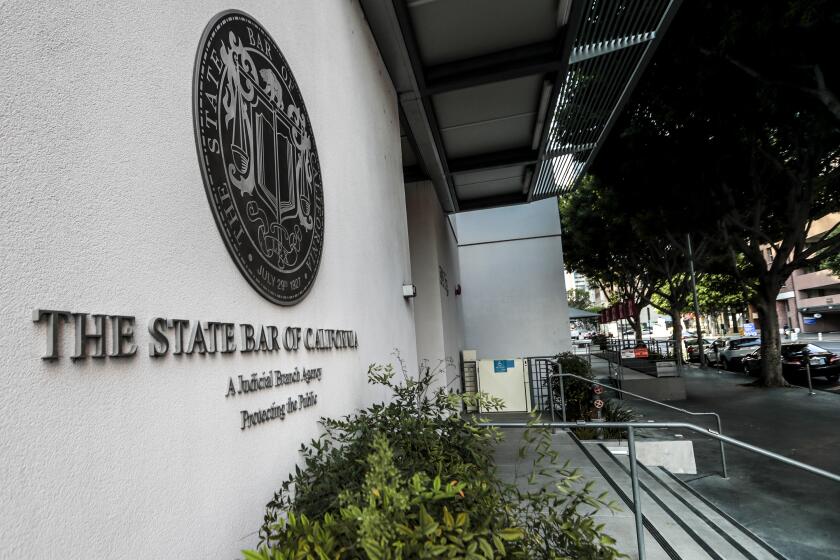Film Helicopter in Desert Crash Lacked Permits
- Share via
The helicopter that crashed in a low-level simulated strafing run during filming of a TV commercial at a remote Mojave Desert site was being flown without the proper federal or local government permits, and the co-pilot, who was killed, may not have been wearing the required safety equipment, officials said Wednesday.
“It was essentially illegal,” said Michael Bobenko, vice president of operations for a quasi-governmental office that issues location shooting permits for the film industry in Los Angeles County.
His agency--the Entertainment Industry Development Corp./Los Angeles Film Office--took the rare step of suspending issuance of new permits to the movie-making company involved, Propaganda Films, “pending our investigation,” Bobenko said.
The co-pilot, Michael Tamburro, may not have been wearing the required safety harness or helmet when the craft’s main rotor clipped an outcropping on a rocky slope during a low-level pass, said Don Llorente, a senior air safety investigator for the National Transportation Safety Board.
The AH-1 Cobra, a former Army attack helicopter, crashed late Tuesday on the film site--known as Club Ed ranch--about 10 miles east of Lancaster, killing Tamburro and injuring Alan Purwin and Christian Fletcher.
Purwin, a pilot and Tamburro’s partner in West Coast Helicopters, a company based at Van Nuys Airport, was in the rear seat of the aircraft. He suffered a broken left wrist in the crash. It was not known whether he was wearing a harness or helmet.
Fletcher, a Woodland Hills stuntman who was standing on the ground near the crash site, was hit by flying debris. Both men were released Wednesday afternoon from the Antelope Valley Medical Center Hospital. Reached by telephone, Fletcher said he had cuts on his legs but was feeling better.
The company was making a commercial for Black & Decker tools, said Pat Kingsley, a company spokeswoman.
Purwin was at the controls as the helicopter descended for a low-level scene chasing a Jeep. Small explosions were to be set off beside the racing Jeep to simulate machine-gun fire from the helicopter.
When the helicopter rotor hit the rock, Llorente said, the aircraft became uncontrollable and it began “shedding parts,” crashing into a flat, sandy stretch of desert surrounded by Joshua trees and brush.
Pieces of the helicopter, including the cracked and blood-stained windshield, were being taken to Compton Airport to be reconstructed as part of the investigation, which will be completed by the board in Washington in six to eight months, Llorente said.
Llorente said the helicopter, built in 1979, was involved in a military accident in 1985 before a private company--Tsirah Corp.--purchased it and rebuilt the aircraft.
Propaganda Films had no permit from the Federal Aviation Administration or the film office to use a helicopter in the scene, said officials from the two agencies. The FAA is also investigating the crash, a spokesman said.
Kingsley said the company had received a permit for special effects, but she acknowledged the permit did not specifically state that the shoot included a helicopter.
“That’s a technicality that they didn’t put the word helicopter on the [permit],” Kingsley said. “They had a firefighter there. He was there on the scene.”
Rob Graham, an inspector with the Los Angeles County Fire Department’s filming and special effects office, said the department had an observer and truck on hand only to monitor the special effects--the small explosions mimicking gunfire.
“Most people in this business understand that a special effects permit is licensed to a pyrotechnician,” Bobenko said. “It has nothing to do with aviation activities.”
Kingsley said the production company was not trying to avoid FAA or film office approval review of the helicopter shots.
“It wasn’t even supposed to be risky,” she said. “In our minds it was more of a misunderstanding than an intentional bypassing of authority. . . . There was nothing done intentionally here.”
Bobenko said it is unusual for a major production company to be banned from shooting at outside locations. The film office investigation--expected to take one to two weeks--will determine whether the agency should assign monitors--at Propaganda’s expense--to the company’s locations to ensure permits are in order, he said.
Propaganda Films, a subsidiary of PolyGram Filmed Entertainment, got its start 10 years ago producing music videos and at one time produced 40% of the videos aired on MTV. The company also is very active in commercial production and has in recent years moved into feature films. The firm produced the 1996 film “Barb Wire” with Pamela Lee, the horror film “Candy Man” and the Madonna documentary “Truth or Dare.”
Bobenko said the Lancaster desert area is highly recommended to film companies because of its remote site. Employees of a company making a rap music video nearby witnessed the crash.
Tamburro was well known in Los Angeles as co-founder of West Coast Helicopters Inc. and had flown for several local news organizations.
Employees of West Coast Helicopters declined to be interviewed. But traffic reporters and photographers said Tamburro was an experienced, well-liked pilot who would not hesitate to fly a plane himself for a news outlet.
“If one of the other pilots couldn’t get a shot for you, he’d take it upon himself to go out and fly,” said Tony Buttitta, a photographer for Channel 13 who flew numerous times with Tamburro. “Every time we’d get the shot.”
Tamburro also flew regularly for the morning news show at KTLA Channel 5.
Tamburro left behind a wife, an 11-year-old son and a 1-year-old daughter, family members said.
He is also survived by a sister and three brothers--two of whom are also helicopter pilots, said a woman who identified herself as his aunt.
Shuster is a Times staff writer; Moeser is a correspondent. Also contributing to this story were Times staff writer Robin Rauzi and correspondent Jill Leovy.
More to Read
Sign up for Essential California
The most important California stories and recommendations in your inbox every morning.
You may occasionally receive promotional content from the Los Angeles Times.










